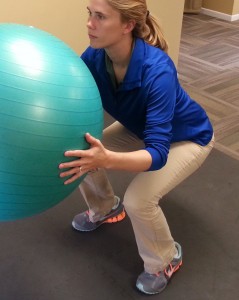Exercise of the Week- Proper Squat
We are starting this week with one of the most important functional exercises that we do everyday: The infamous squat. We perform some form of a squat everyday, either bending over to pick something off the floor or when getting up from a chair or sitting down. We use the major muscle groups, our gluteal muscles, hamstrings, and quadriceps while performing the exercise but a squat is a great overall body exercise.
The Squat:
There are many different types of squats but the main concept is the same. Proper technique is the most important thing that we can teach and preach.
So lets discuss and learn the proper technique. There are a few steps to proper technique.
Feet/knee Position:
Your feet should be about shoulder to hip width apart, with your toes pointed outward 10-20 degrees. The closer you place your feet together, the less stability you will have and the more you will feel it in your front change or quadriceps. The wider your feet are placed, the more you will feel muscle soreness in your hamstrings and gluts. Weight should be distributed along your arch and heel, not on the front toes. Knees should not pass the edge of your toes when in the downward hip and knee bend; the knees should not do past 90
degrees. Thighs parallel to the floor is what we strive for.
Hip Hinge:
The hip hinge helps to unlock your hips and allows your hamstrings to lengthen and release without pain. The hip hinge activates your glut muscles and you should be able to feel the muscles turning on and working. Your buttock should be pushed backwards and downwards during the down phase of the squat.

Knees Parallel to floor and Head up with squat position
Upper Body position: Head/Chest up, Shoulders back
Your chest and shoulders should be up and back and your head shoulder be in alignment with your hips. Your head should be straight and maintaining a neutral spine from the head and neck down to the lower back.
Lower back position:
Your lumbar spine should remain neutral/flat or slightly arched when performing a squat. This is the most important thing to remember in a squat as this protects your lower back against disc injuries. Please remember, a flat back through the entire exercise.
As for the squat itself, start with foot position, push buttock down and out until 90 degrees of knee flexion and then push the hips out and forward. That is a squat.
There are different variations of a squat including the air squat, chair squat and the squat with weights. Start with proper technique and then add weight and resistance as you progress. Proper form insures no injuries and greater gain with strength and performance.
If you have any questions, please feel free to give us a call 402-261-5766 or drop us an email here at the website.

